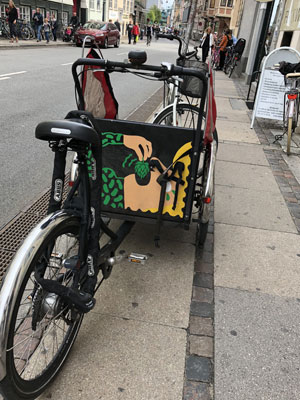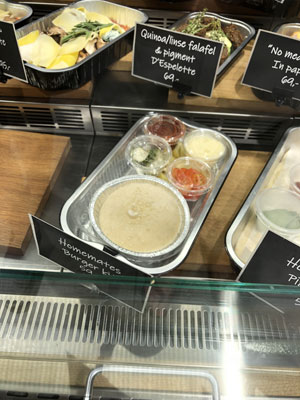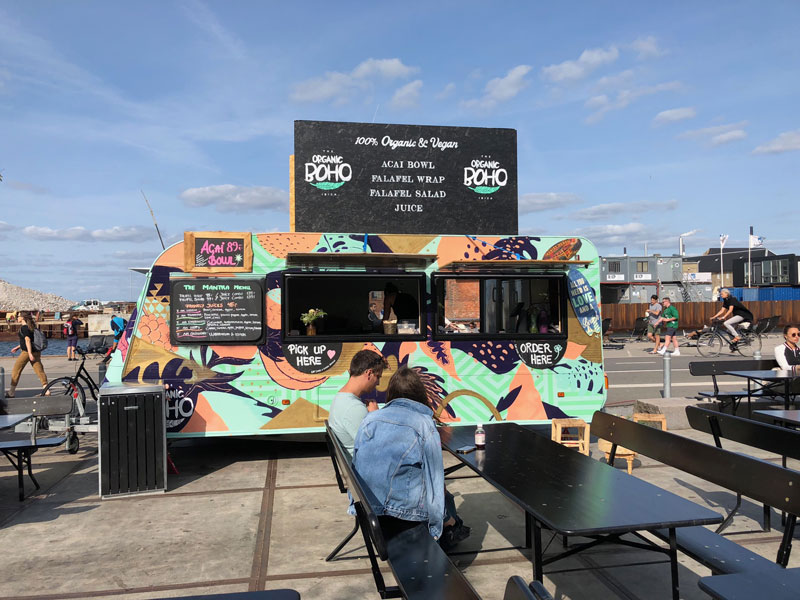There are lots of reasons to pay attention to culinary trends coming out of Denmark.
First of all: Noma, the restaurant claiming the No.1 restaurant in the world distinction for four years is in Copenhagen, along with three-star Geranium and other Michelin Star Restaurants. Organic and vegetarian options are prominent on most menus and outdoor dining along the canals provides one of the longest bar scenes in the world.
Because they bike everywhere—we were told there are two bikes to every person in Copenhagen—Danes build up an appetite for good food. The laws there are written so that the drivers of cars are always  responsible in the case of a bike-versus-car run in. Bike lanes are elevated and separated from both cars and pedestrians. What delivery courier could ask for more?
responsible in the case of a bike-versus-car run in. Bike lanes are elevated and separated from both cars and pedestrians. What delivery courier could ask for more?
The Danes were long considered the happiest people on earth, according to a U.N. report, until Norway toppled them in 2017. And that happiness survives a minimum wage of $18 an hour and high taxes, around 55.8 percent, plus sales taxes in the 25 percent range. Servers are paid a salary plus a commission from the restaurant for what they sell diners (since we were ordering bottled water instead of bottles of wine, we probably weren’t high on their list of favorite customers), plus tips. Although sometimes tips are included in the bill, leading to even more confusion on whether to tip or not.
Students with good grades are paid to go to college and education is free. We were told that being a server, except at the high-end restaurants, isn’t a career, but something that young people do on their way to something else.
In the middle of Copenhagen is Freetown Christiania, where you’re allowed to sell soft drugs, but not take photos. As you leave, there’s a large wooden sign that announces: You are now entering the E.U.
Not a particularly stylish people—almost everyone wore athletic footwear with casual dresses and suits—the Danes seemed to reserve their aesthetics for their architecture, art and food, where they knock it out of the park.
We were there on a two-week vacation, but still manage to do some research in order to bring back some best practices for restaurants looking to how others do delivery.
Food on Demand
In the flagship location for a major department store, a basement food market, reminiscent of a downscaled Harrods food hall in London, was designed for people to pick up a meal or the ingredients for a meal on their way to the metro station.
 It had a small organic produce department, meat and cheese platters, prepared meals, a bakery, bulk nuts and a fish market. Across from it was a huge candy department with everything from high-end chocolates and organic sweets to packaged candy in unnatural colors that looks a bit scary. Apparently, Danes love candy. Maybe it’s because they have a lot of sugar left over from not using so much in their breads and pastries.
It had a small organic produce department, meat and cheese platters, prepared meals, a bakery, bulk nuts and a fish market. Across from it was a huge candy department with everything from high-end chocolates and organic sweets to packaged candy in unnatural colors that looks a bit scary. Apparently, Danes love candy. Maybe it’s because they have a lot of sugar left over from not using so much in their breads and pastries.
What we found unusual, besides selling caviar by the ounce, was a sales booth for Homemate, a service with ready-to-cook meals displayed. Two salespeople manned the booth, where customers could sign up for the service, and check out what a typical meal looks like or buy one. Outside the store in the corridor to catch the train, stood a kiosk where prepared dinners, either single serving or for families, could be picked up on the run. An individual meal featuring falafel was around 69 krones or $10.72 USD. A burger kit was 59 krones or $9.17 USD.
Take-out is referred to as “take away,” and a few stores had the words stenciled on their buildings. Because there’s a plethora of bikes, one would think that bike delivery would be common, but in the two weeks we were there, we only saw two delivery people picking up orders (and we hung around a lot of areas filled with restaurants). Although many bikes had large wooden boxes attached to the front of the bike that are suitable for hauling kids, girlfriends and cargo, the bike couriers we saw had the traditional backpack for food deliveries.
A large open-air “food hall” was located at the base of one of the main bridges that link the islands in Copenhagen. An ample area of picnic tables was ringed by both food trucks and permanent booths. Cuisine ranged from a burger place called Gasoline Grill to organic and vegan bowls to Mexican and Italian food. Not much housing was nearby, and it almost looked like a camp that sprung up in a major corridor.
In the smaller town of Odense, a modern food court had that same setting indoors. Downstairs was a large bar that served all the drinks for the food booths on two levels. By having all the drinks come from one source, the individual small box kitchens didn’t have to accommodate a beverage cooler. Most were ethnic restaurants.
We were told most Danes tend to eat meals at home with the family—talking to each other, not concentrating on their phone screens. So while the food delivery may not be as ramped up as in the U.S., the Danes newfound organic, fresh food lifestyle, may skip the middleman down the road and deliver directly from farms.


